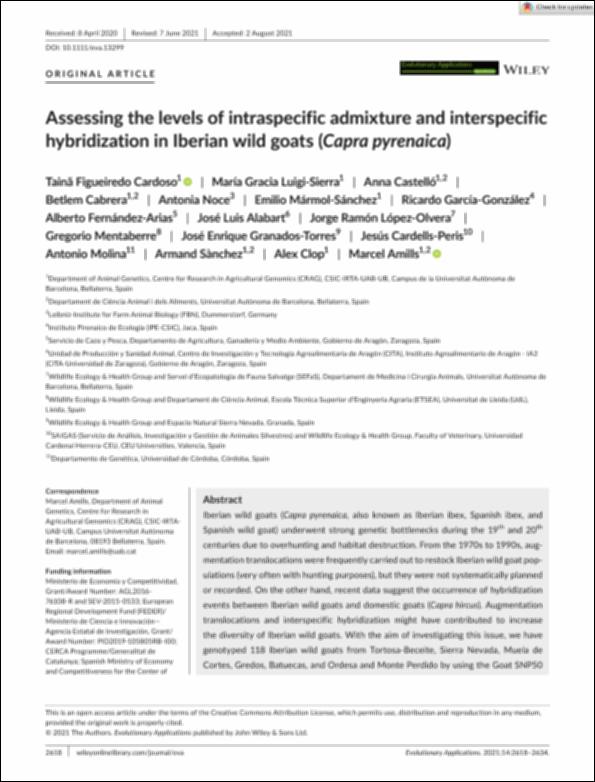Por favor, use este identificador para citar o enlazar este ítem:
http://hdl.handle.net/10637/13546Assessing the levels of intraspecific admixture and interspecific hybridization in Iberian wild goats (Capra pyrenaica)
| Título : | Assessing the levels of intraspecific admixture and interspecific hybridization in Iberian wild goats (Capra pyrenaica) |
| Autor : | Figueiredo Cardoso, Taina Luigi Sierra, María Gracia Castelló Farré, Anna Cabrera, Betlem Noce, Antonia Mármol Sánchez, Emilio Cardells Peris, Jesús |
| Materias: | Cabras - Genética.; Biodiversidad.; Rupicapra - Genetics.; Goats - Genetics.; Cabras montesas - Genética.; Biodiversity. |
| Editorial : | John Wiley & Sons |
| Citación : | Cardoso, T. F., Luigi-Sierra, M. G., Castelló, A., Cabrera, B., Noce, A., Mármol-Sánchez, E. et al.(2021). Assessing the levels of intraspecific admixture and interspecific hybridization in Iberian wild goats (Capra pyrenaica). Evolutionary Applications, vol. 14, i. 11 (nov.), pp. 2618–2634. DOI: https://doi.org/10.1111/eva.13299 |
| Resumen : | Iberian wild goats (Capra pyrenaica, also known as Iberian ibex, Spanish ibex, and Spanish wild goat) underwent strong genetic bottlenecks during the 19th and 20th centuries due to overhunting and habitat destruction. From the 1970s to 1990s, augmentation translocations were frequently carried out to restock Iberian wild goat populations (very often with hunting purposes), but they were not systematically planned or recorded. On the other hand, recent data suggest the occurrence of hybridization events between Iberian wild goats and domestic goats (Capra hircus). Augmentation translocations and interspecific hybridization might have contributed to increase the diversity of Iberian wild goats. With the aim of investigating this issue, we have genotyped 118 Iberian wild goats from Tortosa-Beceite, Sierra Nevada, Muela de Cortes, Gredos, Batuecas, and Ordesa and Monte Perdido by using the Goat SNP50 BeadChip (Illumina). The analysis of genotypic data indicated that Iberian wild goat populations are strongly differentiated and display low diversity. Only three Iberian wild goats out from 118 show genomic signatures of mixed ancestry, a result consistent with a scenario in which past augmentation translocations have had a limited impact on the diversity of Iberian wild goats. Besides, we have detected eight Iberian wild goats from Tortosa-Beceite with signs of domestic goat introgression. Although rare, hybridization with domestic goats could become a potential threat to the genetic integrity of Iberian wild goats; hence, measures should be taken to avoid the presence of uncontrolled herds of domestic or feral goats in mountainous areas inhabited by this iconic wild ungulate. |
| Descripción : | Este artículo se encuentra disponible en la siguiente URL: https://onlinelibrary.wiley.com/doi/epdf/10.1111/eva.13299 En este artículo de investigación también participan: Ricardo García-González, Alberto Fernández- Arias, José Luis Alabart, Jorge Ramón López-Olvera, Gregorio Mentaberre, José Enrique Granados-Torres, Antonio Molina, Armand Sànchez, Alex Clop y Marcel Amills. |
| URI : | http://hdl.handle.net/10637/13546 |
| Derechos: | http://creativecommons.org/licenses/by-nc-nd/4.0/deed.es |
| ISSN : | 1752-4563 1752-4571 (Electrónico) |
| Fecha de publicación : | 24-nov-2021 |
| Centro : | Universidad Cardenal Herrera-CEU |
| Aparece en las colecciones: | Dpto. Producción y Sanidad Animal, Salud Pública Veterinaria y Ciencia y Tecnología de los Alimentos |
Los ítems de DSpace están protegidos por copyright, con todos los derechos reservados, a menos que se indique lo contrario.


